 As the COVID-19 pandemic creates an array of unprecedented pressures on society, and on parents and children, its impacts are likely to be felt intensely in pregnancy and maternity. To mark Maternal Mental Health Awareness Week, Dr Ranjana Das, Reader in Media and Communication at the University of Surrey and LSE alumni, outlines the potential impacts from the rapid move to online support to meet the needs of isolated new mums. Discussing her new book, Early Motherhood in Digital Societies: Ideals, Anxieties and Ties of the Perinatal, she argues in favour of a strategy for maternal digital well-being which distinguishes the specific needs of mothers and offers integrated digital and offline service provision.
As the COVID-19 pandemic creates an array of unprecedented pressures on society, and on parents and children, its impacts are likely to be felt intensely in pregnancy and maternity. To mark Maternal Mental Health Awareness Week, Dr Ranjana Das, Reader in Media and Communication at the University of Surrey and LSE alumni, outlines the potential impacts from the rapid move to online support to meet the needs of isolated new mums. Discussing her new book, Early Motherhood in Digital Societies: Ideals, Anxieties and Ties of the Perinatal, she argues in favour of a strategy for maternal digital well-being which distinguishes the specific needs of mothers and offers integrated digital and offline service provision.
New mothers reach out to online spaces, but not without consequences
It was on one of the PND (postnatal depression) groups … there’s quite a lot of women that have put their heart out there and said what it’s like, and I thought do you know what, I’m going to do it, it might help me within myself. I didn’t even tell my family about it for a long time. Because I, I felt ashamed, I felt embarrassed. – Christine
Mothers spoke of using online spaces and ties to find information and support whilst on long waiting lists, in the middle of the night when helplines were closed, and on intimate issues they felt unable to disclose to anyone else.[1] Many gaps in time and space seemed to be bridged digitally.
The role of offline support networks is complex and should not always be assumed to be helpful. Many women felt surveiled by large family networks on the ground, and for many, short-lived online ties often became emotionally significant and had lasting impacts, in both positive and negative instances.
Intersectional experiences within easy-to-form groupings of perinatal mothers remind us not to reduce digital practices to individual narratives. Socio-economic status for instance significantly intersected any easy-to-use grouping such as ‘migrant mothers’ and their perinatal experiences. Equally, many mothers were not online, many who were online appeared to seek information only and not support, and for many, telephony including internet telephony continued to be significant.
And last, the morally intense nature of some online environments within broader, gendered structures meant that not all peer support spaces online were uniform or uniformly useful. My book attempts to nuance these conversations significantly using face-to-face interviews with 34 new, in addition to research on a range of online platforms.
What are the implications for practice and policy?
First, maternal wellbeing, particularly in the perinatal period before and after childbirth, has long interested professionals, the popular press and the public. It is usually seen as an individualized, clinical condition, which is linked, via discourses of real and inferred blame, to its impacts on the fetus/infant. In contrast, we must study perinatal wellbeing not as an isolated, individual condition, but tied to broader, gendered societal norms and structures – for instance, the pressure on women to mother intensively.
Second, in England, Health Visiting services are struggling owing to public funding cuts. As the BMA notes, “Despite the high prevalence rate of perinatal mental health problems, the provision of perinatal services has been poor”. The NHS has long had a relationship with the digital, and sometimes, like in many other areas of public life, these discourses aligning with techno-euphoric stances. As Harvey notes:
“it has been challenging to judge the impact of digital healthcare solutions in England despite powerful rhetoric regarding its transformational potential; society, it appears, is unconvinced of this potential” (2015, p. 537).
The Five Year Forward View for Mental Health predicts, optimistically that digital technology is going to play a crucial role in developing mental health services and the Wachter Review highlights the importance of a digital NHS system that would improve the quality of healthcare and lower costs at the same time. In the light of these policy contexts, there is a case for both optimism and caution in terms of the potential role of the digital in supporting new parents, or for digital initiatives, including peer support, to make a difference for perinatal mental health. This also became apparent as technologies for mental health support become a point of significant interest amidst the COVID-19 pandemic.
What might the findings from my work mean for the NHS and for existing perinatal mental health support organisations and charities in terms of using digital pathways to support mums perinatally?
- The government need to ensure continued support for offline perinatal services (for which the digital is not a substitute). This is currently under significant threat with the closure of Sure Start Children’s Centres. This is of particular relevance in the midst of COVID-19, when we must remember that the lack of offline support avenues will continue to have a significant impact despite online support avenues rapidly emerging – one does not replicate or replace the other.
- The government and third sector organisations need to ensure that training of offline services across sectors includes training on digital well-being. Offline sources of support should be able to guide mothers to useful online avenues. This may also mean that certain offline avenues frequented by women who otherwise lack access or the appropriate levels of digital literacies to connect to the kinds of existing, informal support available, might make available resources and advice for women to begin accessing online environments to find information, support and connect with others.
- Healthcare professionals on the NHS (for instance, Health Visitors) who do meet mothers offline, in their own homes for instance, need to be equipped to develop a clear sense of the gaps being filled by existing digital provisions and of community and peer-led services already out there, so that they might both recommend avenues with appropriate words of caution if required as findings above show.
- The NHS and the very active third sector and community-based online peer-support based fora and provisions need to work together, subject to appropriate vetting and scrutiny. This could mean the availability of healthcare professionals on some of these spaces, at certain times. Building partnerships with existing in/semi-formal online communities is key, whilst recognising that peer support is a complex matter and should not lead to an additional burden for support communities.
- Expanding NHS’s current library of mobile apps for well-being needs to include maternal well-being in a non-commercial context. My findings showed that apps continue to be significant for many who do not seek support or camaraderie, but solely information, online. Building focused apps and digital sites to better support mothers, drawing lessons from existing informal, community-led platforms is a useful next step.
None of this is likely to be straightforward and depends significantly on resourcing. Maternal, indeed parental, and family well-being is linked to children’s health and well-being, yet grouping these together does not do sufficient justice to the individuals involved. A concrete and distinct place for maternal digital well-being, separate from digital child health in the NHS digital strategy, would go a long way in distinguishing and recognising the specific needs of mothers, as diverse as their contexts are, and developing contextualised and measured solutions which researches and recognises these specificities and differences. Such a strategy would need to be context-sensitive and note issues around access and diversity in cultural approaches to healthcare and health information seeking that characterises maternity in the U.K.
Notes
This post gives the views of the authors and does not represent the position of the LSE Parenting for a Digital Future blog, nor of the London School of Economics and Political Science.
[1] Mothers were interviewed at home, face to face, with 5 interviewed online. Participants were recruited through word-of-mouth and snowballing, and interviews lasted between 1 to 2 hours. More information on the fieldwork can be found in the free-to-download Chapter 1 in the preview of my book.
Featured image: Photo by Filiz Mehmed on Unsplash





